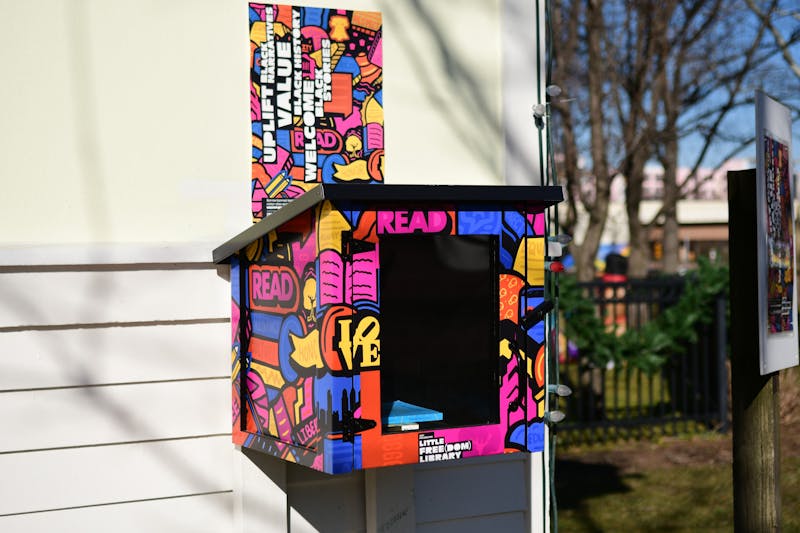While Penn’s campus is filled with students bemoaning weekly recitation readings or long winded lectures on Dickensian classics, many can recall a time when reading was considered a pastime rather than an obligation. Often, one imagines a child, nestled in a cozy corner, wide–eyed as they crack open a new book. Immersed in a state of literary wonder, the child is transported to realms across the globe as they traverse alongside literature’s most valiant protagonists.
However, this idealistic rendering of reading as an inherent ability rather than a taught skill neglects to consider how various differences impact children’s ability to delve into the literary worlds revered by their classmates. Attempting to combat declining literacy rates in Philadelphia’s public school system, a new bill in Harrisburg aims to bolster student’s reading comprehension through the science of reading movement.
Cleared by the Senate Education Committee at the beginning of February, the bill would require teachers to implement "evidence–based" reading into their curricula and screen students K–3 three times a year to monitor levels of reading competency. Despite pushback, an amended version of the bill was passed by the Pennsylvania State Education Association, which will allow school districts to submit a revised curriculum to the state Department of Education for review.
Under the amended bill, the department will be expected to create a 20–person council that will work closely with educators to curate a list of evidence–based reading for students. Beyond curriculum revisions, teachers will be expected to participate in state–mandated training under the department. If the bill continues to advance, Pennsylvania will become the latest of at least 37 states to mandate evidence–based reading instruction.
Despite the bill’s admirable intentions, it has garnered widespread controversy as educators and parents debate the need to reform current reading instruction.
"To the extent that these laws remove teacher choice from certain decisions about curriculum and pedagogy and instructional style, it’s not at all a surprise that you’d see unions be in opposition to those, even if they support the arguments behind the science of reading," Melissa Arnold Lyon, an assistant professor of public policy at the University at Albany, says in an interview with Education Week.
Many educators fear that advocates of the movement are erroneously portraying evidence–based reading techniques as a "magic bullet" solution to an issue that requires a much more comprehensive approach. Additionally, teachers argue that policies’ speedy implementation fails to consider the time it takes to realistically shift established educational practices and pedagogical tendencies.
"We can’t just suddenly say, 'Tomorrow, all reading classes will be the science of reading,' and expect that on a moment’s notice, everything just shifts," Keith Gambill, the president of the Indiana State Teachers Association says in an interview with Education Week. "To simply say, 'This is what we’re going to do,' and you send every teacher into a couple days' worth of training or, even worse, a few sessions after school, and expect them in the next year to be experts in this—that’s absolute folly.”
Despite ongoing criticism, calls for structured literacy in classrooms have continued to spread across the nation. The science of reading movement promotes the idea that educators should use cognitive research studies to shape their approach in teaching young children key literacy skills. The research suggests that children must have a strong comprehension of phonics, the connection of spoken sound to individual letters and phrases, before tackling other facets of literacy. Leaders of the movement aim to dispel the prevailing idea of reading as "natural" by emphasizing how scientific evidence draws an irrefutable connection between sequenced instruction in phonics and the production of confident young readers.
A strong advocate for evidence–based reading instruction, Nancy Scharff works as a literacy consultant for Read by 4th, a citywide campaign that aims to advance Philadelphia’s literacy movement and protect children’s right to read.
Scharff has been involved in educational work for the past 23 years, specifically focusing on supporting special educational needs for children with high incidence disabilities. Developing close relationships with children struggling to tackle literacy, she has been a central figure of Read by 4th since the initiative’s conception.
"The Read by 4th campaign is based on collective impact, which is focused on bringing all the disparate resources of the city together," Scharff says in an interview with 34th Street Magazine. "It’s nonprofit, it’s foundations, it’s systems, and it’s charters; it brings together nonprofits to work on addressing reading issues. The focus is working with families, communities, and systems and exploring how we can bring those parties together."
In order to equip the next generation of educators with the requisite skills required to produce confident readers, Read by 4th convenes state–wide professor summits and aims to expand science of reading aligned student teaching models.
“We want to make sure that aspiring teachers are knowledgeable and that they have all the skills they need before they enter the classroom,” Scharff said.
Beyond basic teacher preparation, the initiative seeks to deepen educators' knowledge of the science of reading movement by providing them with professional development resources, promoting community learning, and advocating for the state’s support in reforming teachers' professional development. Additionally, by calling for a broader implementation of structured literacy across the educational system, they aim to mitigate declining literacy rates among younger students in Philadelphia’s public schools, which would be particularly helpful to children with dyslexia.
“Currently, there are ten to 15 percent of kids that are dyslexic and need code–based, explicit, systematic, sequential, diagnostic instruction with a lot of repetitions,” Scharff says. “But 40 to 50 percent, to really become proficient readers, need this type of systematic instruction. There’s 35 percent of kids where learning to read is completely natural, and for five percent of kids, it’s completely effortless. But what we know is that structured literacy is vital to this 65 percent, and it is a huge advantage for reading and spelling to even the top 35 and 40 percent.”
Despite the movement’s positive community benefits, efforts to expand structured literacy practices have been met with an onslaught of backlash. However, Scharff believes that parents’ opposition to the movement is misguided.
“There’s a disconnect between many educators—teachers, reading specialists, principals, superintendents— about what it takes to learn to read and what methods are effective,” Scharff says. “This is a change, and change is hard. There are established frameworks that people have been taught and have been using for teaching reading, and to introduce something new is difficult.”
Echoing Scharff’s sentiments, Maria Toglia, the leader of the Statewide Higher Ed Community of Practice, expounds upon the debate of balanced versus structured literacy and its broader implications of students’ reading comprehension.
The concept of balanced literacy first emerged in the 1990s as a compromise between whole language and phonics instruction. While whole language instruction focused on using a text’s context to decipher its meaning, phonics–based instruction was centered on employing standard phonetic rules. A balanced literacy approach merges the two modes of teaching to help students develop well–rounded reading skills. However, critics of balanced literacy claim that evidence–based reading offers a broader range of benefits for students learning to read.
“People were focused on balanced literacy for a long time because there was vigorous promotion by people widely known, so it became entrenched, not only in Pennsylvania, but all around the country,” Toglia says in an interview with Street. “The difference between balanced literacy and structured literacy is that structured literacy is based on science and peer–reviewed research. The practices that come out of those research findings directly inform the explicit, systematic way of teaching kids to read that is based on teaching them the code of the English language.”
Toglia has been involved in promoting literacy for the past ten years, working in various positions as a certified school psychologist, a director of capacity building for the Pennsylvania branch of the International Dyslexia Association, and a co–chair of Read by 4th’s teacher preparation task force. In particular, her passion for supporting students struggling with reading literacy was sparked by her son’s battle with dyslexia and the lack of support he received in Philly’s public school systems.
“From a personal perspective, my son is a young man with dyslexia, so, as a mother, I was advocating for him early on to get the instruction that he needed, and that’s what brought me to the IDA,” Toglia said.
Referencing the long–lasting psychological implications associated with children’s low literacy rate, she believes that structured literacy provides children with the instruction they need to flourish in all aspects of life.
"As a school psychologist, I have worked with many kids who have struggled to read," Toglia said. "It’s the number one reason that children get referred for special education. As a school psychologist, I do special education evaluations, so I am able to see firsthand what happens when kids are able to get the right instruction from knowledgeable teachers, and then I can see what happens when they’re not able to get that instruction and how it impacts them negatively across the curriculum, as well as socially and emotionally. Many kids who struggle to read also experience anxiety and depression."
By fourth grade, 70 percent of children in Philadelphia are reported to read below grade level. However, the science of reading movement aims to galvanize a shift in literacy education across the nation that will give every child the opportunity to reach their full literary potential. Many states that have already integrated a structured literacy approach into their curriculum have witnessed a noticeable rise in students' literacy rates in a short amount of time. Following the state’s shift towards a structured literacy curriculum, Mississippi went from being ranked 49th out of 50th on the National Assessment of Educational Progress in fourth grade reading in 2012 to holding the 21st spot in 2022.
Through addressing the diverse needs of learners, the broader implementation of evidence–based reading instruction equips students with the foundational skills necessary to attain academic success across all subject areas. Although it may appear paradoxical, science has the power to preserve the magic of literature deep within the hearts of Philadelphia’s next generation of readers.






